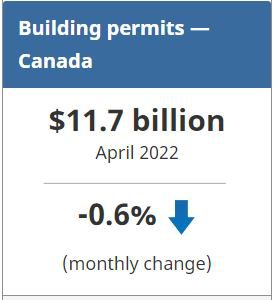Statistics Canada: Building Permits, April 2022
The total value of building permits in Canada declined 0.6% in April to $11.7 billion. Decreases in residential permits (-3.3%) were mostly offset by gains in the non-residential sector (+5.0%).
On a constant dollar basis (2012=100), the total value of building permits increased 0.5% to $7.5 billion.
Residential sector pulls back following strong month
Residential permits in April decreased 3.3% to $7.7 billion nationally, driven mostly by lower intentions in Ontario and British Columbia, while seven provinces posted increases.
Construction intentions in the single-family home component declined 2.0%, with Alberta (-11.9%) behind much of the decrease.
The value of multi-family building permits pulled back 4.4%, as Ontario (-21.7%) returned to more normal levels following a strong February and March.
Ontario pushes up non-residential sector
The total value of permits in the non-residential sector advanced 5.0% to $3.9 billion in April. The industrial component surged 35.1%, stemming from large gains in Ontario (+48.8%) due to permits for several mining buildings in Greenstone.
Commercial permits decreased 6.4%, with most of the declines in British Columbia as the province returned to more normal levels following a high value permit for the Oakridge Centre redevelopment issued in March.
Construction intentions in the institutional sector rose 7.2%. Ontario posted the largest gain, reflecting the expansion project of the Runnymede Healthcare Centre in Toronto and a new elementary school in Kingsville.
To explore data using an interactive user interface, visit the Building permits: Interactive Dashboard.
To explore the impact of the pandemic on the socioeconomic landscape, please consult the Canadian Economic Dashboard and COVID-19.
For more information on housing, please visit the Housing statistics portal.
Statistics Canada has a Housing Market Indicators dashboard. This web application provides access to key housing market indicators for Canada, by province and by census metropolitan area. These indicators are updated automatically with new information from monthly releases, giving users access to the latest data.
For the full press release, click here.
Note to readers
Unless otherwise stated, this release presents seasonally adjusted data with current dollar values, which facilitate month-to-month and quarter-to-quarter comparisons by removing the effects of seasonal variations. For information on seasonal adjustment, see Seasonally adjusted data – Frequently asked questions.
Building components
- Single-family dwellings: Residential buildings containing only one dwelling unit (e.g., single-detached house, bungalow, linked home [linked at the foundation]).
- Multi-family dwellings: Residential buildings containing multiple dwelling units (e.g., apartment, apartment condominium, row house, semi-detached house).
- Industrial buildings: Buildings used in the processing or production of goods, or related to transportation and communication.
- Commercial buildings: Buildings used in the trade or distribution of goods and services, including office buildings.
- Institutional and government buildings: Buildings used to house public and semi-public services, such as those related to health and welfare, education, or public administration, as well as buildings used for religious services.
Revision
Unadjusted data for the current reference month are subject to revisions based on late responses. Data for the two previous months have been revised. Seasonally adjusted data for the previous three months have also been revised. As per Statistics Canada practices, data for the previous year have been revised. Seasonally adjusted data for the previous three years have also been revised.
For information on trend-cycle data, see the StatCan Blog and Trend-cycle estimates – Frequently asked questions.
Next release
Data on building permits for May will be released on July 5.
Source: Statistics Canada


